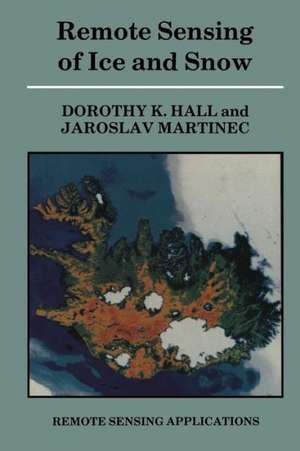Remote Sensing of Ice and Snow: Remote Sensing Applications
Autor Dorothy Hallen Limba Engleză Paperback – 26 sep 2011
Preț: 383.33 lei
Nou
Puncte Express: 575
Preț estimativ în valută:
73.37€ • 76.31$ • 61.48£
73.37€ • 76.31$ • 61.48£
Carte tipărită la comandă
Livrare economică 13-27 martie
Preluare comenzi: 021 569.72.76
Specificații
ISBN-13: 9789401086479
ISBN-10: 9401086478
Pagini: 212
Ilustrații: X, 189 p.
Dimensiuni: 155 x 235 x 11 mm
Greutate: 0.3 kg
Ediția:Softcover reprint of the original 1st ed. 1985
Editura: SPRINGER NETHERLANDS
Colecția Springer
Seria Remote Sensing Applications
Locul publicării:Dordrecht, Netherlands
ISBN-10: 9401086478
Pagini: 212
Ilustrații: X, 189 p.
Dimensiuni: 155 x 235 x 11 mm
Greutate: 0.3 kg
Ediția:Softcover reprint of the original 1st ed. 1985
Editura: SPRINGER NETHERLANDS
Colecția Springer
Seria Remote Sensing Applications
Locul publicării:Dordrecht, Netherlands
Public țintă
ResearchCuprins
1 An introduction to the optical, thermal and electrical properties of ice and snow.- 1.1 Introduction.- 1.2 Optical and thermal properties of ice and snow.- 1.3 Electrical properties of ice and snow.- References.- 2 Sensors and platforms.- 2.1 Introduction.- 2.2 Multispectral Scanner (MSS) on the Landsat series.- 2.3 Thematic Mapper (TM) on Landsats 4 and 5.- 2.4 NOAA satellites and sensors.- 2.5 Heat Capacity Mapping Mission (HCMM).- 2.6 Nimbus 5 and 6 Electrically Scanning Microwave Radiometer (ESMR) and Nimbus 7 Scanning Multichannel Microwave Radiometer (SMMR).- 2.7 Passive microwave aircraft sensors.- 2.8 Synthetic Aperture Radar (SAR).- 2.9 Seasat SAR and radar altimeter.- 2.10 Impulse radar.- References.- 3 Snow cover.- 3.1 Snow cover in the global water balance.- 3.2 Snow properties.- 3.3 Seasonal snow cover.- 3.4 Snow-cover mapping.- 3.5 Snow-cover depletion curves.- References.- 4 Applications of remotely derived snow data.- 4.1 Hydrological importance of snow.- 4.2 Snowmelt-runoff modelling.- 4.3 Discharge forecasts.- 4.4 Economic benefits.- References.- 5 Lake and river ice.- 5.1 The importance of lake and river ice.- 5.2 Freshwater ice thickness studies.- 5.3 Lake depth and ice thickness studies in northern Alaska.- 5.4 Ice in large lakes and estuaries.- 5.5 River ice break-up.- 5.6 Ice jams and aufeis.- References.- 6 Permafrost.- 6.1 Hydrological and geological implications of permafrost.- 6.2 Vegetation mapping in permafrost areas.- 6.3 Snow and ice break-up.- 6.4 Surface temperature and energy balance studies.- 6.5 Tundra surface disturbances.- 6.6 Subsurface probing of permafrost.- References.- 7 Glaciers, ice caps and ice sheets.- 7.1 Global significance of glaciers.- 7.2 Distribution and mass balance of glaciers.- 7.3 Catastrophic events: surges,jökulhlaups and rapid glacier movement.- 7.4 Greenland and Antarctic ice sheets.- 7.5 Icebergs.- 7.6 Radio echo sounding of glacier ice.- References.- 8 Sea ice.- 8.1 Introduction.- 8.2 Sea ice age.- 8.3 Sea ice type and interannual variability.- 8.4 Sea ice concentration.- 8.5 Sea ice movement.- References.




